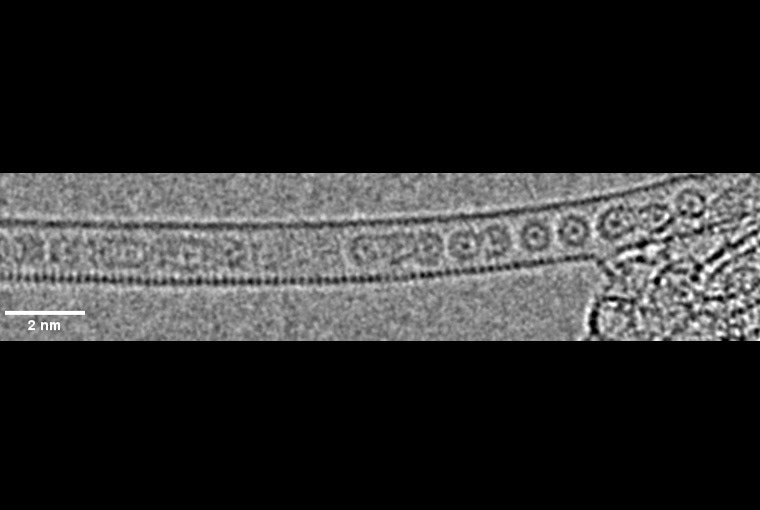For the first time, the noble gas krypton (Kr) atoms have been effectively trapped inside a carbon nanotube to create a one-dimensional gas.

Image Credit: The University of Nottingham
Researchers from the School of Chemistry at the University of Nottingham captured the moment when Kr atoms united, one by one, inside a “nano test tube” container that had a diameter half a million times smaller than that of a human hair using cutting-edge transmission electron microscopy (TEM) techniques. American Chemical Society published the research.
Scientists have been examining the behavior of atoms since the idea that they are the fundamental building blocks of the cosmos was proposed. Atomic movement significantly affects basic phenomena, including fluid flow, pressure, temperature, and chemical reactions.
Conventional spectroscopic techniques can analyze the motion of large atomic groups and use averaged data to explain atomic-scale events. These techniques, however, cannot depict the actions of individual atoms at a given moment in time.
Atoms can move at very high rates of around 400 m/s in the gas phase, depending on the speed of sound, which presents a problem for researchers when imaging them. Atoms range in size from 0.1 to 0.4 nanometers. This makes it extremely difficult to image atoms in operation directly, and one of the biggest scientific problems to date is the development of continuous visual representations of atoms in real-time.
Carbon nanotubes enable us to entrap atoms and accurately position and study them at the single-atom level in real-time. For instance, we successfully trapped noble gas krypton (Kr) atoms in this study. Because Kr has a high atomic number, it is easier to observe in a TEM than lighter elements. This allowed us to track the positions of Kr atoms as moving dots.
Andrei Khlobystov, Professor, School of Chemistry, University of Nottingham
Professor Ute Kaiser, former head of the Electron Microscopy of Materials Science group and Senior Professor at the University of Ulm, added, “We used our state-of-the-art SALVE TEM, which corrects chromatic and spherical aberrations, to observe the process of krypton atoms joining together to form Kr2 pairs. These pairs are held together by the van der Waals interaction, which is a mysterious force governing the world of molecules and atoms. This is an exciting innovation, as it allows us to see the van der Waals distance between two atoms in real space. It is a significant development in the field of chemistry and physics that can help us better understand the workings of atoms and molecules.”
The scientists transferred individual Kr atoms into nano test tubes using Buckminster fullerenes, football-shaped molecules with 60 carbon atoms. The tests’ accuracy was enhanced by the buckminsterfullerene molecules’ coalescence to form nested carbon nanotubes.
Krypton atoms can be released from the fullerene cavities by fusing the carbon cages. This can be achieved by heating at 1200 °C or irradiating with an electron beam. Interatomic bonding between Kr atoms and their dynamic gas-like behavior can both be studied in a single TEM experiment.
Ian Cardillo-Zallo, PhD Student, University of Nottingham
The team has witnessed firsthand how Kr atoms escape fullerene cages to create a one-dimensional gas. Kr atoms can only travel down the nanotube channel in one dimension after being released from their carrier molecules because of the incredibly small spacing. Similar to vehicles stuck in traffic, the atoms in the row of restricted Kr atoms are compelled to slow down to avoid colliding with one another.
The critical moment when isolated Kr atoms change into a 1D gas and the single-atom contrast in the TEM vanishes was caught by the researchers. Nevertheless, by mapping the chemical fingerprints of each nanotube, the complementary methods of electron energy loss spectroscopy (EELS) and scanning TEM imaging were able to track the migration of atoms within each one.
By focusing the electron beam to a diameter much smaller than the atomic size, we are able to scan across the nano test tube and record spectra of individual atoms confined within, even if these atoms are moving. This gives us a spectral map of the one-dimensional gas, confirming that the atoms are delocalized and fill all available space, as a normal gas would do.
Quentin Ramasse, Director, SuperSTEM, EPSRC National Research Facility
Professor Paul Brown, director of the Nanoscale and Microscale Research Centre, added, “As far as we know, this is the first time that chains of noble gas atoms have been imaged directly, leading to the creation of a one-dimensional gas in a solid material. Such strongly correlated atomic systems may exhibit highly unusual heat conductance and diffusion properties. Transmission electron microscopy has played a crucial role in understanding the dynamics of atoms in real-time and direct space.”
To learn more about these peculiar states of matter, the team intends to employ electron microscopy to capture temperature-controlled phase transitions and chemical processes in one-dimensional systems.
Journal Reference:
Cardillo-Zallo, I., et. al. (2024) Atomic-Scale Time-Resolved Imaging of Krypton Dimers, Chains and Transition to a One-Dimensional Gas. American Chemical Society. doi:10.1021/acsnano.3c07853.